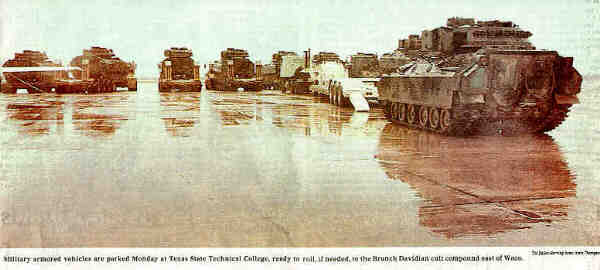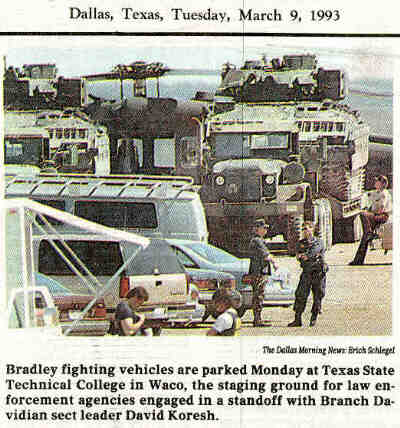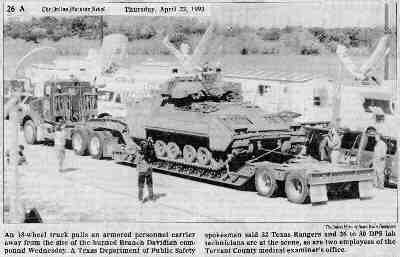
|
16.
|
|
"Military armored vehicles are parked Monday at Texas State Technical College, ready to roll, if needed, to the Branch Davidian Compound west of Waco." The Dallas Morning News, March 2, 1993. Given that this is a morning paper, this picture was taken no later than March 1, the day after the initial raid. |
"The siege has become a focal point for the world's special forces eager to see the latest equipment being applied in a real crisis. Observer teams from the American Delta Force and British Special Air Service have already visited Waco." (The Sunday Times, March 21, 1993).
The US by far had the superior forces — tanks, armed helicopters, commandos, state and local police — and could surely have overwhelmed the people in the rambling farmhouse. Yet for 51 days the US "negotiated" with the Davidians and allowed the siege to play out on the national and international stage.
A common dictionary will define negotiation as the act or procedure of coming to terms with, or reaching an agreement with, another. Negotiations imply a rough equality between negotiators — both parties have something of value that the opposite party would like to share.
As already pointed out, the Department of Justice Report (DOJ Report) admits to the deployment of at least 17 tanks; add to that almost a thousand commandos and policemen and numerous helicopters, with free access to the US Treasury.
The docile news services were stationed three miles away, facing the front of the Mt. Carmel Center (facing center stage). The back and the sides of the building (stage sides and stage back) did not even have the appearance of being under observation. Under the cover of night and the constant noise of the helicopters and the psychological warfare sound technologies, the US could have arguably entered and left the Mt. Carmel Center at any time it chose.
Strange Negotiation Tactics
Nor did the FBI act as if they were conducting negotiations. Few parties in a negotiation will cut off the opposite side's electricity, phone lines, blast them with noise night and day, throw grenades, and drive tanks around their home smashing automobiles and kids' toys. If these were "negotiations," the word has been redefined.
But the siege did provide an opportunity to use the residents of the Mt. Carmel Center as a national testbed in which besieged civilians' reactions and resistance to military force was tested; the news coverage of the siege provided a testbed for the gullibility of the American public. Just how much newspeak would America swallow?

|
|
Bradly fighting vehicles are parked Monday at Texas State TechicalCollege in Waco, the staging ground for law enforcement agencies engaged in standoff with Branch Davidian sect leader David Koresh. (The Dallas Morning News, March 9, 1993) |
Civilian Head of FBI Told to Take a Walk
On March 6, FBI director William Sessions intervened personally and offered to talk with Koresh directly to bring matters to a peaceful conclusion. It is significant that he was denied the opportunity by the tactical section of the FBI. (DOJ Report, pg. 131). The excuse was that the move would "inject the FBI Director into the operational process and possibly impair needed objectivity." In other words, the military (HRT) core of the FBI was in control of the siege, not the head of the FBI's civilian facade.
Now let's look at how the Davidians were subjected to diverse and bizarre treatments that gradually increased in intensity.
First Amendment Canceled
We have already seen that the Texas Rangers sealed off the Davidians' residence from the very beginning of hostilities (Treasury Report, pg. 79). By March 1, the FBI had cut all the Branch Davidians' telephone lines and replaced them with lines which connected them to the FBI (Treasury Report, pg. 28). The news services were kept three miles from Mt. Carmel the site, in a location known as "satellite city." All communication from the Branch Davidians had to go through the FBI.
"During the siege, the HRT maintained the inner perimeter, the SWAT teams maintained an outer perimeter, and various agencies, mainly the Texas Highway Patrol, manned various checkpoints on the roads leading to the compound." (DOJ Report, pg. 150).
"Additionally, throughout the standoff, families and friends of those inside the compound appeared unannounced at checkpoints requesting to go inside. While those individuals turned out not to be security risks, the danger that a friend or relative might try to slip into the compound was always present." (DOJ Report, pg. 153). How would this be a danger, unless the friend or relative might learn some piece of the truth and talk?
Davidians Imprisoned with Tanks, Grenades, and Concertina Wire
The FBI claimed during the siege that it wanted the Branch Davidians to get out from under David Koresh's "control" and to leave the Mt. Carmel Center. The most direct way to do this was of course to allow the Davidians free egress from the building. However, the FBI set up formidable barriers which made the Davidians prisoners in the Mt. Carmel Center.
Tanks: By March 1, the FBI had moved in armored vehicles "to help secure the inner perimeter." Yet, remember, the FBI claimed it wanted the Branch Davidians to come out.
Grenades: On March 10, "numerous individuals came out of the compound, walked around, then went back inside. It appeared from these actions that they were attempting to test the resolve of the agents, since the FBI had warned people not to come outside without first obtaining permission." (DOJ Report, pg. 62). And from whom were the Davidians to ask permission? Was there someone inside the Mt. Carmel Center who was directing releases, or otherwise acting as a liaison for the FBI? On what basis would such "permission" be granted?
March 18. At 1:34 p.m., Supervisory Senior Resident Agent (SSRA) FBI agent "negotiator" Brian Sage began to speak to those inside the compound over the loudspeaker system in an attempt to communicate directly with everyone, to urge everyone to come out. Sage told them they would be treated fairly, that they were free to come out …" (DOJ Report, pg. 73).
"Stay Inside!" "Come Out!" The FBI was playing with the Branch Davidians as a cat plays with a mouse before the kill.
The DOJ Report states that in April, "individuals inside the compound were exiting unannounced with ever-increasing frequency," and that they "only returned to the inside after being "flash-banged." (DOJ Report, pg. 153). A "flash-bang" is a type of grenade used by the ATF and the FBI during the initial assault and siege. Rather than being harmless as the agencies claimed, the devices have caused severe bodily injury, including dismemberment. The Branch Davidian attorneys called one such victim to the stand during the 1994 San Antonio trial of the Branch Davidians The victim, Sandra Sawyer, a mother of four, was at a friend's house when it was raided by the police, who threw flash-bangs into the home. Ms. Sawyer's right hand was almost severed, and, at the time of the trial, she had undergone six reconstructive surgeries. (Transcript, pg. 6806-13).
There we have it. In order to keep them inside the building, the FBI threw explosive devices at the Branch Davidians. Flash bangs were thrown at the Davidians regularly throughout the siege. Psychiatrist Dr. Bruce D. Perry, who had interviewed the Davidian children who left the Mt. Carmel Center, wrote a memo to the FBI on March 11. He "described the children's 'many, many, many, allusions to explosions' and raised questions about whether the compound had booby traps or was wired to explode," (The Dallas Morning News, May 4, 1993, pg. 13A). If Dr. Perry were to read the DOJ Report, he would perhaps understand to what the children were referring.
Another report published by the Department of Justice, the DOJ Dennis Report, also cites many instances of the Branch Davidians being flash-banged by the FBI to prevent them from leaving the building.
On April 10, the FBI erected concertina (razor) wire around the building. (DOJ Report, pgs. 102, 145).
Tanks, grenades, razor wire — all used to keep people inside a building. This was a strange way to encourage them to leave the building. It is obvious that the Davidians were hostages of the FBI, kept like fish in a barrel.
Electricity Turned Off
From March 9 the FBI began to turn the electricity off and then on again. On March 12 the electricity was turned off for good. Despite the presence of babies and children inside, FBI agent Jeff Jamar said that the electricity was turned of "because he wanted those inside the compound to experience the same wet and cold night as the tactical personnel outside …" (DOJ Report, pg. 142). The Davidians complained "that the people were cold and freezing inside the compound." (DOJ Report, pg. 68).

|
|
"An 18-wheel truck pulls an armored personnel carrier away from the site of the Branch Davidian Compound Wednesday. A Texas Department of Public Safety spokesperson said 32 Texas Rangers and 35 DPS lab technicians are at the scene, as are two employees of the Tarrant County medical examiner's office." (The Dallas Morning News, April 22, 1993) |
Radio, TV Signals Jammed
We have already seen that the US government installed high-tech monitoring devices inside the Mt. Carmel Center, and that the ham radio tower was taken down before the February 28 raid. The government also engaged in other high tech electronic warfare against the Branch Davidians. Actions included jamming SOS signals being transmitted by the Davidians and jamming incoming radio and TV signals.
Jamming of radio and TV signals is strictly prohibited by US law, and can be carried out only in extreme situations such as war or national security emergencies. President Clinton himself would have had to sign the order (Communications Act of 1934, 47 USC 706(a) and (c)).
The FBI jammed TV and radio signals as part of its psychological warfare against the Davidians (The Dallas Morning News, April 17, 19, 1993). Signals were jammed almost completely during the day and night to prevent the Davidians from hearing news of support from other Americans. The only signals permitted into Mt. Carmel's airspace during the siege were those carrying FBI news conferences, in which David Koresh was held up to scorn and the religious views of the Davidians were ridiculed. Through listening devices, the FBI then studied the Branch Davidian responses to the briefings.
"You could hear them yelling and screaming about 'FBI agent' Ricks and 'BATF agent' Troy, yelling and screaming about 'how' people were lying about them … That came mostly from Schneider," an FBI official told The Dallas Morning News.
The jamming equipment was supplied by the Federal Communications Commission — the very body entrusted with enforcing the Federal Communications Act.
Morse Code Signals Jammed
On the night of March 14, 1993, and on the following night, Morse Code messages were flashed by Branch Davidians switching an overhead light on and off. The messages came from the fourth floor residential tower of the Mt. Carmel Center. The flashing lights were picked up by TV cameras, captured on video tape, and later analyzed.
Associated Press reported issued a report stating that it had analyzed the transmissions, that that the message was this: SOS SOS SOS FBI BROKE NEGOTIATIONS. WANT NEGOTIATIONS FROM THE PRESS. The Dallas Morning News (March 16, 1993, pg. 12) reported the same message, but said the message had been transmitted with a flash light.
The Morse Code transmissions were also studied by George Zimmerlee, a Marietta, Georgia electronics expert who designs and builds prototype electronic equipment. He is an amateur radio operator, and holds an FCC General Radiotelephone (Operator) License. On the night the signal began, stadium lights were focused into the room from which the signals were being transmitted. The Morse Code signals were obscured by the much brighter stadium lights. The cameras also began panning back and forth so that viewing of the signal was interrupted during crucial transmission periods. Apparently the government was alerted to the Branch Davidian plans by listening devices planted inside Mt. Carmel. "Much of what the Branch Davidians transmitted has been lost," says Zimmerlee.
Interfering with SOS signals violates several international laws, including the International Telecommunications Convention of Atlantic City, 1947 (Article 44) and the UN International Covenant on Civil and Political Rights, Part III, Article 19. The SOS message met the International Telecommunication Union Rules (Article 37) definition of a distress signal.
Davidians Wayne Martin or Jeff Little, now both dead, probably sent the code, says Zimmerlee. Both were ham radio operators, knew Morse code, and had a proficiency of 20 words per minute. "They were sending coherent, very readable code — exquisitely good, it was very readable," says Zimmerlee.
"Communications in this military operation was a high priority target. The government has lied about the nature and purpose of the raid. Evidence of jamming shows that there was something extremely dangerous about permitting the Branch Davidians to communicate with the outside world," says Zimmerlee.
Mr. Zimmerlee has carried his objection all the way to Rep. Newt Gingrich (R-Ga.), Speaker of the House of Representatives in the US Congress. A letter of response from the FBI to Congressman Gingrich was returned to Zimmerlee (see page 1 and page 2 of that letter).
Mind Manipulation Experiments

|
|
"Day 23. Federal agents begin psychological warfare. They blare taped chants of the Tibetan monks through loudspeakers and shine blinding lights into the compound." (Newsweek, May 3, 1993, pg. 29.) |
The Waco siege was also a testbed for mind manipulation experiments. In mid-March, bright stadium lights were brought in to interfere with the Morse code the Davidians were sending (see above). These lights were retained and shone during the night to deprive the Davidians of sleep. Eyewitnesses say the noise level around Mt. Carmel was unbearable. Low flying helicopters continually hovered over the buildings and tanks circled the house.
The FBI brought in loudspeakers, and through the speakers came the high decibel sounds of laughter, birds squawking, sirens, rabbits being slaughtered, rock music, Tibetan chants, and recordings of "negotiation" sessions held between the Branch Davidians and the FBI (DOJ Report, pgs. 69, 73, 79).
"March 22. The negotiators called Schneider at 9:03 a.m. Schneider was still angry about the loud music which had included Tibetan chants. The negotiators attempted to calm him by blaming the FBI tactical agents; however, Schneider remained angry …" (DOJ Report, pg. 79).
On March 23, the Department of Justice report states that Davidian Steve Schneider, with whom the FBI was "negotiating" "had become very combative and argumentative" (DOJ Report, pg. 81).
"March 24. After several attempts, the negotiators reached Steve Schneider at 9:52 a.m. Still angry over the loud music, Schneider refused to talk any further that day." (DOJ Report, pg. 83)
The whole purpose of the negotiation, allegedly, was to reason with the Davidians and encourage them to "do the right thing" — to surrender. But they were forbidden to leave the "compund" and as prisoners, tortured with ear-splitting noise and blinding lights, depriving them of sleep for weeks at a time. Of course the Davidians were "angry" and "combative."
Acoustic Psycho-Correction Technology
Noise was also a key factor in the siege of Noriega's retreat in Panama in 1990, when US forces blasted high volume rock music and other sounds into the building day and night. (Grenada, Panama, and Haiti: Joint Operational Reform, pg. 61, cached). The noise in Panama and Waco may have been used as a cover for a new thought implant technology called "acoustic psycho-correction."
Acoustic psycho-correction attempts to implant thoughts in the target's mind without the target being aware of the source of the thought. A voice of someone known to the target is synthesized and transmitted through loud noise; the target hears the voice, and is supposed to believe the message is his own thought. The technology was the subject of author Dick Russell's article in Prevailing Winds magazine in 1995. Says Russell:
Last July, an article in the monthly periodical Defense Electronics described a series of secret meetings held last March in suburban Northern Virginia between US intelligence officials and a group of Russian scientists. They were talking, the article maintained, "about the Russians' decade-long research on a computerized acoustic device allegedly capable of implanting thoughts in a person's mind without that person being aware of the source of the thought." The FBI was apparently considering using the Russian device - dubbed "acoustic psycho-correction" - on David Koresh, sending in the voice of God (or, alternatively, of the cult leader's mother) in an effort to get the Branch Davidians to emerge. But the Russian scientists allegedly refused "to promise zero risk."When the NIJ's David Boyd was asked recently whether any non-lethal weapons were considered for use in Waco, he responded: "I have to answer that very carefully. The fairest answer is, none were suitable." (Prevailing Winds, Vol. 1, 1995, "Non-Lethal Weapons" by Dick Russell).
Notice the hedging in Boyd's answer, and notice the lack of denial. No, maybe the non-lethal weapons were not "suitable." Maybe they didn't work in the predicted manner.
Next: Now visit the Fire Gallery
Back: Directory of Exhibits
Back: Introduction to the War Gallery
Home: Museum Entrance
Search: Museum
Text
This Museum was originally hosted at public-action.com. Published by Public Action, Inc, a news and news analysis service. |